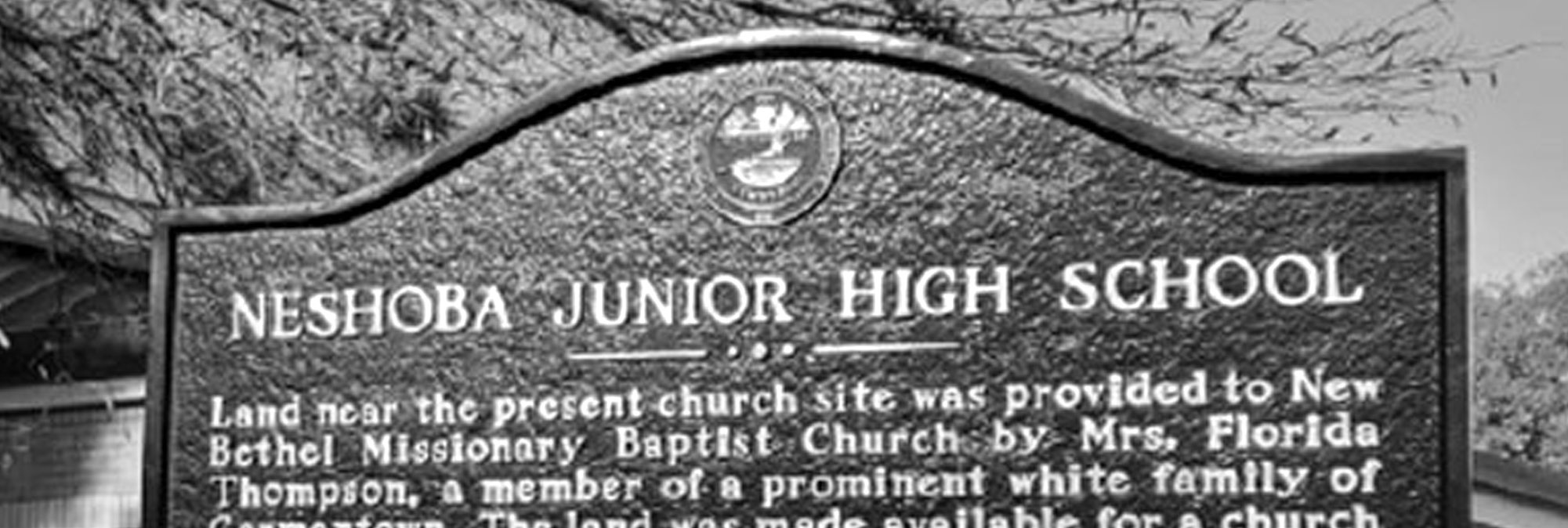
Neshoba Junior High School
History of Neshoba Junior High School
Land near the present church site was provided to New Bethel Missionary Baptist Church by Mrs. Florida Thompson, a member of a prominent white family of Germantown. The land was made available for a church structure, known then as a brush arbor, where slaves could worship and learn to read and write. When these slaves became emancipated, this land was purchased for $200 from Mrs. Eliza Cornelius in 1869. In 1886 New Bethel Church deeded one acre of land to the 11th School District for the establishment of a school for the African-American community for the first time and it was named Germantown School. Under the leadership of its first pastor, Rev. Isaac Cotton, Germantown School opened on a portion of the land. Philanthropist Julius Rosenwald of Chicago provided construction funds.
As the church grew, it bought another piece of land adjacent to the church in 1897 and deeded that to Shelby County for a new school. The site where the old school had been reverted to the church to be used as the church cemetery. The name was changed to Neshoba School in 1912. In 1917 the New Bethel Baptist Church deeded three more acres to the Shelby County Board of Education to improve the facilities and it was renamed Neshoba Junior High School. The church and the school prospered through fundraisers sponsored by the church. In 1930 the church bought another three acres of land adjacent to its property from Minor and Ada Callis in order to improve the school’s facility. The school principal, Professor N. G. Watkins, worked diligently to expand the elementary school to junior high. He also was responsible for getting school bus transportation for the students of Neshoba School, because some children had been walking as far as 15 miles to attend school.
When the church burned in 1937, it held services in the Neshoba School auditorium. However, by 1939 church services were held in a new church building. The church and the Neshoba School grew and prospered through the 1940s, ’50s, and ’60s. The school remained in operation until 1969. Then it closed as a result of desegregation and consolidation of schools. With the desegregation of the 1960s, the Neshoba School property was bought back by the New Bethel Baptist Church in 1972 to be used as an educational and recreational building. In 2001 the church and the entire town were saddened by the loss of the historical educational building by fire.
During its years of operation, the school had many dedicated principals and educators who expressed the importance of education and knowledge to all students. Most of these students went on to become productive citizens, although living through the dark days of segregation.
They moved forward in their lives, knowing the early history of New Bethel Missionary Baptist Church, where worship and praise have continued. Praise continued into the 21st Century under the leadership of Pastor Dr. Donald R. Ester. Due to the influence of these principals and educators, students were expected to succeed. Principals were Rev. Jack Bradley, Rev. R.H. Neville, Nicholas Watkins, J. Simmons, Henry Grinner, B.J. Calvard, Mrs. Mary Bradford, and Mrs. Gazella Watkins Brown.
The Neshoba Alumni Association and the Shelby County Historical Commission erected and unveiled a historical marker on November 3, 2018, titled “NESHOBA JUNIOR HIGH SCHOOL”, on property belonging to New Bethel Missionary Baptist Church at 7782 Poplar Pike. The two-sided marker reads as follows:
NESHOBA JUNIOR HIGH SCHOOL
Land near the present church site was provided to New Bethel Missionary Baptist Church by Mrs. Florida Thompson, a member of a prominent white family of Germantown. The land was made available for a church structure, known then as a brush arbor, where slaves could worship and learn to read and write. When these slaves became emancipated, this land was purchased for $200 from Mrs. Eliza Cornelius in 1869. In 1886, under the leadership of its first pastor, Rev. Isaac Cotton, Germantown School opened on a portion of the land. Philanthropist Julius Rosenwald of Chicago provided construction funds. The name was changed to Neshoba School in 1912. Renamed by 1917 as Neshoba Junior High School, it remained in operation until 1969. Then it closed as a result of desegregation and consolidation of schools.
ERECTED BY THE NESHOBA ALUMNI ASSOCIATION AND THE SHELBY COUNTY HISTORICAL COMMISSION, NOVEMBER 2018
NESHOBA JUNIOR HIGH SCHOOL
During its years of operation, the school had many dedicated principals and educators who expressed the importance of education and knowledge to all students. Most of these students went on to become productive citizens, although living through the dark days of segregation. They moved forward in their lives, knowing the early history of New Bethel Missionary Baptist Church, where worship and praise have continued. Praise continued into the 21st Century under the leadership of Pastor Dr. Donald R. Ester. Due to the influence of these principals and educators, students were expected to succeed. Principals were Rev. Jack Bradley, Rev. R.H.Neville, Nicholas Watkins, J. Simmons, Henry Grinner, B.J. Calvard, Mrs. Mary Bradford, and Mrs. Gazella Watkins Brown.
ERECTED BY THE NESHOBA ALUMNI ASSOCIATION AND THE SHELBY COUNTY HISTORICAL COMMISSION, NOVEMBER 2018


